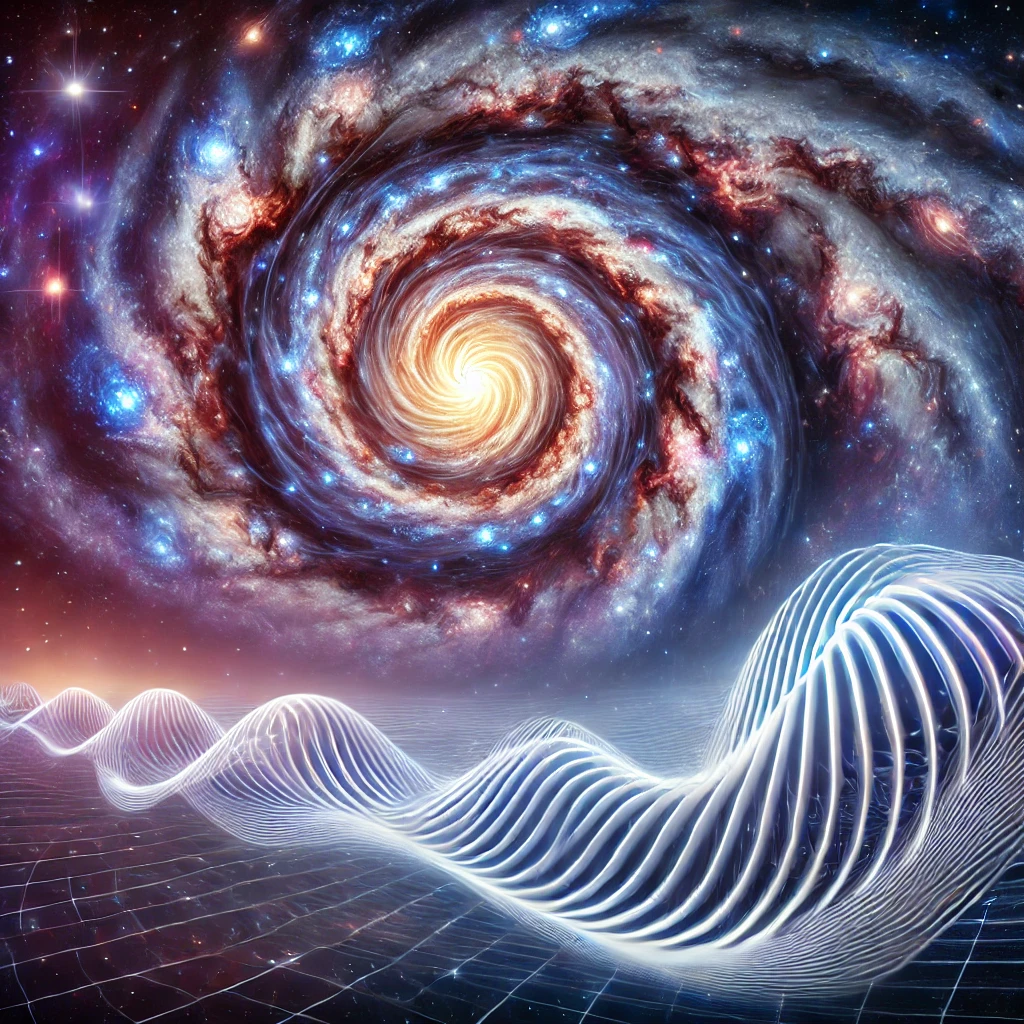
Formation of Galaxies: Emergence from the First Cosmic Movement
In Vibrational Field Theory, the formation of galaxies is seen as a direct consequence of the first movement or fluctuation in the universal field. This initial ripple of energy, originating from the field’s first disturbance, laid the groundwork for the self-organization of large-scale structures like galaxies. While the process shares similarities with how solar systems and planets form, it occurs on a much grander scale, with gravitational interactions, dark matter, and cosmic waves coming together to create the vast, dynamic structures we see in the universe today.
The First Movement: A Cosmic Ripple that Seeds the Universe
The first fluctuation in the universal field initiated the process by which the universe’s structure began to emerge. This cosmic ripple spread out, amplifying as it moved through space, creating areas of energy density that would later evolve into galaxies. Galaxies, in this view, are massive resonant patterns in the field, stabilized by the interaction of gravitational forces, dark matter, and gas.
Instead of thinking of galaxies as random accumulations of matter, Vibrational Field Theory suggests they are the result of the self-organizing vibrations in the cosmic field, which were triggered by the initial ripple.
The Early Universe: A Sea of Primordial Vibrations
Shortly after the first movement, the universe was a hot, dense, and rapidly expanding field of energy and particles. This can be thought of as a chaotic sea of vibrations within the universal field, with the first fluctuations becoming the seeds for galaxy formation. These fluctuations provided the blueprints for the structures that would later grow into galaxies and galaxy clusters.
Cosmic Microwave Background (CMB)
The CMB, the faint radiation left over from the early universe, provides evidence of small fluctuations in temperature. In Vibrational Field Theory, these fluctuations are seen as the earliest vibrational disturbances in the field, the echoes of the initial cosmic ripple. Over billions of years, these small vibrational differences would amplify and organize into the large-scale cosmic structures we observe today.
Gravitational Instability and the Collapse of Vibrational Patterns
As the universe expanded, certain regions of this vibrational sea became denser due to gravitational interactions. These dense areas began to collapse under their own gravitational pull, marking the birth of galaxies.
In Vibrational Field Theory, this collapse represents vibrational nodes in the field where energy becomes more concentrated. These nodes become the centers of galaxy formation.
Dark Matter’s Role
Dark matter, which does not interact with light but exerts a gravitational pull, acts as a kind of scaffolding for galaxies. In Vibrational Field Theory, dark matter represents a different type of vibration in the field—one that doesn’t interact electromagnetically but still influences the organization of matter. These dark matter vibrations help draw together gas and dust, forming the dense regions that eventually become galaxies.
Gravitational Waves as Vibrational Drivers
As these dense regions collapse, they generate gravitational waves—ripples in the field caused by the movement of massive objects. These waves act as cosmic shockwaves, helping to organize matter into defined structures such as galaxies, further amplifying the original vibrations from the first movement.
The Birth of Galaxies: Spirals and Ellipticals
As the vibrations in the field continue to lead to the collapse of dense regions, galaxies begin to take shape. In Vibrational Field Theory, a galaxy is a massive resonance in the field—a stable, swirling pattern of energy and matter that forms over billions of years.
Spiral Galaxies: Swirling Vibrational Patterns
Spiral galaxies, like the Milky Way, are characterized by their majestic spiral arms. These spirals are the result of resonant waves in the field, where the central mass of the galaxy collapses into a dense core, often housing a supermassive black hole. The outer regions of gas and stars begin to organize into spiraling wave patterns, which are areas where the vibrations in the field create density waves—compressing stars and gas into repeating patterns that form the iconic spiral shape.
- Rotation and Harmony: The stars and gas in a spiral galaxy rotate around the center in a balanced, harmonic motion, much like the orbits of planets around a star. This motion is the result of the vibrational balance between the galaxy’s central mass and its outer regions, with the arms of the galaxy being where the vibrational energy is most pronounced.
Elliptical Galaxies: Spherical Vibrational Modes
Elliptical galaxies have a more rounded shape and lack the defined structure of spirals. In Vibrational Field Theory, these galaxies form from more chaotic vibrations in the field. The collapse of matter in elliptical galaxies is less organized, resulting in a more spherical or elliptical shape. These galaxies are often older, with stars that move in more random directions, representing a damped vibrational mode in the field.
Galaxy Clusters and Superclusters: Large-Scale Vibrational Structures
Galaxies don’t exist in isolation. They are often part of larger systems known as galaxy clusters and superclusters, which are even larger structures that span millions of light-years. In Vibrational Field Theory, these massive structures are the result of long-wavelength vibrations in the cosmic field.
Clusters as Resonances
A galaxy cluster is essentially a resonance of vibrations on a larger scale than individual galaxies. These clusters are regions where the cosmic field has organized into stable, repeating patterns that gather galaxies into close proximity, forming massive cosmic webs.
- Dark Matter’s Role in Clusters: Once again, dark matter vibrations play a crucial role in organizing galaxy clusters. In this theory, dark matter creates the gravitational “wells” that keep galaxies bound together in clusters, helping maintain the stability of these large-scale structures.
Supermassive Black Holes: The Central Vibrational Anchor
At the center of most galaxies lies a supermassive black hole, which in Vibrational Field Theory represents the ultimate concentration of vibrational energy. These black holes act as vibrational sinks—places where the vibrations of matter and energy collapse inward, creating intense gravitational waves that ripple outward and help maintain the structure and dynamics of the galaxy.
Black Holes as Energy Concentrators
A supermassive black hole can be thought of as a vibrational sink—a place where vibrations concentrate to such an extent that matter and energy can no longer escape. This intense concentration of energy creates strong gravitational distortions in the field, influencing the orbits of stars and gas throughout the galaxy.
Stabilizing the Galaxy
The presence of a supermassive black hole helps to stabilize the overall vibrational pattern of the galaxy. The gravitational pull of the black hole acts as an anchor, ensuring that the stars and gas in the galaxy maintain their orbits in a stable, resonant system.
How This Theory Explains Galaxy Formation
What Role Does Dark Matter Play? Dark matter provides the scaffolding for galaxies, acting as vibrations in the field that help gather normal matter (gas and stars) into organized structures.
Why Do Galaxies Form? Galaxies form as a result of the first movement—the natural collapse and organization of vibrations in the cosmic field. These vibrations, amplified from the initial ripple, gather matter and dark matter into the gravitational wells that become galaxies.
Why Do Galaxies Have Different Shapes? The shape of a galaxy depends on the vibrational patterns that form during its collapse. Spiral galaxies are more organized, with resonant waves creating spiral arms, while elliptical galaxies form from less organized, more chaotic vibrations in the field.



Leave a Reply